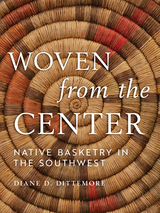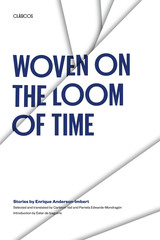2 books about Woven

Woven from the Center
Native Basketry in the Southwest
Diane D. Dittemore
University of Arizona Press, 2024
In the beginning was basketry. Around the world, the intertwining of fibers by hand to form a container is a most ancient of crafts. It is older than pottery and metalwork, older than loom weaving.
Woven from the Center presents breathtaking basketry from some of the greatest weavers in the Southwest. Each sandal and mat fragment, each bowl and jar, every water bottle and whimsy is infused with layers of aesthetic, cultural, and historical meanings. This book offers stunning photos and descriptions of woven works from Tohono O’odham, Akimel O’odham, Hopi, Western Apache, Yavapai, Navajo, Pai, Paiute, New Mexico Pueblo, Eastern Apache, Seri, Yaqui, Mayo, and Tarahumara communities.
This richly illustrated volume stands on its own as a definitive look at basketry of the Greater Southwest, including northern Mexico. It also serves as a companion to the peerless collection of U.S. Southwest and Northwest Mexican Native American basketry curated at the Arizona State Museum in Tucson, Arizona. Comprehensive in its coverage, this work is based on decades of research on weavers, collectors, and donors. It includes ample illustrations of basket weavers, past and present, bringing to life the people behind these wonderful woven treasures.
Woven from the Center presents breathtaking basketry from some of the greatest weavers in the Southwest. Each sandal and mat fragment, each bowl and jar, every water bottle and whimsy is infused with layers of aesthetic, cultural, and historical meanings. This book offers stunning photos and descriptions of woven works from Tohono O’odham, Akimel O’odham, Hopi, Western Apache, Yavapai, Navajo, Pai, Paiute, New Mexico Pueblo, Eastern Apache, Seri, Yaqui, Mayo, and Tarahumara communities.
This richly illustrated volume stands on its own as a definitive look at basketry of the Greater Southwest, including northern Mexico. It also serves as a companion to the peerless collection of U.S. Southwest and Northwest Mexican Native American basketry curated at the Arizona State Museum in Tucson, Arizona. Comprehensive in its coverage, this work is based on decades of research on weavers, collectors, and donors. It includes ample illustrations of basket weavers, past and present, bringing to life the people behind these wonderful woven treasures.
[more]

Woven on the Loom of Time
Stories by Enrique Anderson-Imbert
Selected and translated by Carleton Vail and Pamela Edwards-Mondragón
University of Texas Press, 1990
Argentinian scholar and writer Enrique Anderson-Imbert is familiar to many North American students for his La Literatura de América Latina I and II, which are widely used in college Spanish courses. But Anderson-Imbert is also a noted creative writer, whose use of "magical realism" helped pave the way for such writers as Borges, Cortázar, Sábato, and Ocampo. In this anthology, Carleton Vail and Pamela Edwards-Mondragón have chosen stories from the period 1965 to 1985 to introduce English-speaking readers to the creative work of Enrique Anderson-Imbert. Representative stories from the collections The Cheshire Cat, The Swindler Retires, Madness Plays at Chess, Klein's Bottle, Two Women and One Julián, and The Size of the Witches illustrate Anderson-Imbert's unique style and world view. Many are "short short" stories, which Anderson-Imbert calls casos (instances). The range of subjects and points of view varies widely, challenging such "realities" as time and space, right and wrong, science and religion. In a prologue, Anderson-Imbert tells an imaginary reader, "Each one of my stories is a closed entity, brief because it has caught a single spasm of life in a single leap of fantasy. Only a reading of all my stories will reveal my world-view." The reader asks, "And are you sure that it is worth the trouble?" Anderson-Imbert replies, "No." The unexpected, ironic ending is one of the great pleasures of reading Enrique Anderson-Imbert.
[more]
READERS
Browse our collection.
PUBLISHERS
See BiblioVault's publisher services.
STUDENT SERVICES
Files for college accessibility offices.
UChicago Accessibility Resources
home | accessibility | search | about | contact us
BiblioVault ® 2001 - 2024
The University of Chicago Press









